Moffat Takadiwa is a Zimbabwean artist well-known for creating work from found provides. His exhibition Vestiges of Colonialismcurated by Please the Cryeropened on the Nationwide Gallery of Zimbabwe on 16 March. That’s the 40-year-old Takadiwa’s first solo current in Zimbabwe in a decade. Having exhibited spherical the globehe’s best acknowledged for his sculptures created from shopper waste and concrete residues similar to toothbrushes, computer keyboards and low value perfume bottles.
As an paintings historian specializing in trendy Zimbabwean paintings, I have been researching the artist’s work for the previous couple of years. With stunning, big scale sculptural works and installations, this exhibition unveils a map of the artist’s ideas and divulges a profound and progressive home brimming with music, crops, soil, time and frequently life.
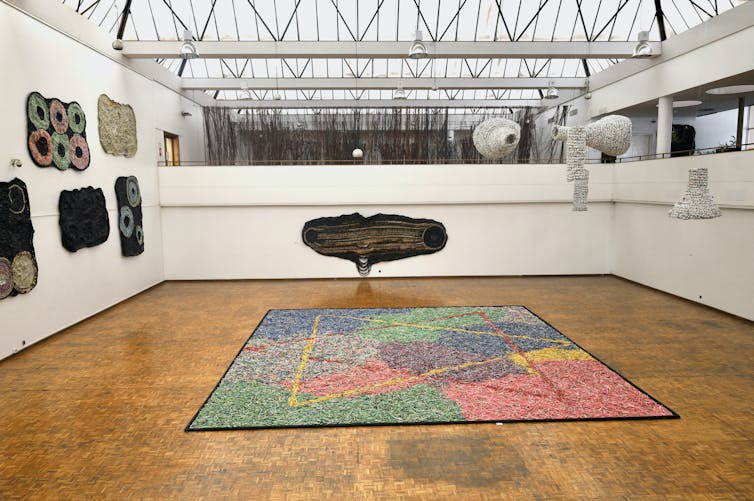
Lifang Zhang
Vestiges of Colonialism simply is not solely a landmark current, however as well as a nicely timed dialog on colonial legacies in Zimbabwe. By collaborating with the works, one discovers delicate vestiges of colonial constructions which will be knitted into the fabric of Zimbabwean society and proceed to impact people’s lives within the current day.
Colonial hangover
Stepping into the gallery, a buyer’s eye is immediately drawn to magnificent sculptures mounted on a two-storey wall. Made out of toothbrush heads and computer keys, this sculpture sequence, Korekore Handwriting, is the artist’s acknowledgement of the people who type his apply. Belonging to the Korekore people of Zimbabwe’s broader Shona ethnic cluster, Takadiwa’s practices are intently influenced by the neighborhood’s weaving custom and collective strategy of labour.
Positioned on the centre of the underside flooring is an arrange titled Stroll of Shame that includes 1000’s of toothbrush handles. Sooner than being organized by hue and framed in a giant picket sq., they’ve been truly residues piled up in entrance of Takadiwa’s studio at Mbare Paintings Home. To entry the studio, one wanted to navigate this path of handles, taking care to not journey and fall. Over time, they’ve collected reminiscences and histories of many people who’ve trodden on them, as evidenced by the soil, grime and odour affixed to them. Drawing from the Hollywood Stroll of Famethe artist examines the path one could take to get ahead whereas grappling with residues of colonialism and worldwide commerce.
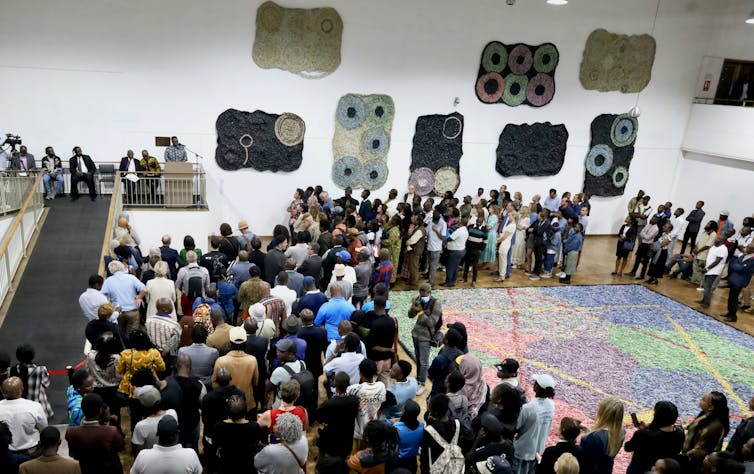
Lifang Zhang
These things present the materiality of Takadiwa’s work. He has been working with shopper waste as a result of the late 2000s when a movement to redefine paintings provides emerged in Harare in the midst of the nation’s socio-economic catastrophe. With years of experimenting, Takadiwa has developed his private seen language and mode of working with these frequently objects. Residues at the moment are not merely paintings provides to him nevertheless a metaphor for post-colonial conditions, what he phrases a colonial hangover. Most of his sculptural work features a strategy of deconstruction and reconstruction of the provides by many palms. It is a gesture within the path of and a question in regards to the prospects of transformation by collective work.
A question of land
The gallery’s ramp leads company to a particular however related home, which they should not solely observe, however as well as experience. A chunk titled Rugare Kwamuri presents a floating yard alongside the corridor, with rugare greens grown in burnt furnishings drawers of the kind utilized by the colonial administration hanging beneath the dome lights. Rugare is a loaded phrase in native lingo that truly interprets to peace or good life. It is the Shona time interval for the standard variety of kale which may be current in unusual households.
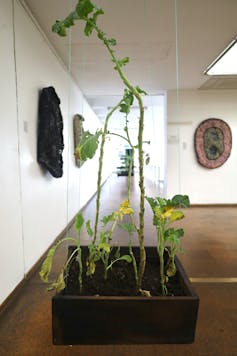
Lifang Zhang
Farmers throughout the northern space of South Africa search recommendation from the vegetable as “muRhodesia”, indicating its historic affiliation with the colonial state of Rhodesia, renamed Zimbabwe. Rugare will be the title of an earlier township in Harare. It was constructed by Rhodesia Railways to accommodate its native workers, separated from the white settlers. The colonial legacy of a poor constructed ambiance – properties, roads, medical and tutorial infrastructures – has barely modified within the current day.
Rugare moreover reveals an affinity with land. As a result of the vegetable grows to realize massive sizes, its peak signifies the scale of time a household has resided in a dwelling, a brand of a gradual life. However, as recognized by one viewers member, to start with, one might want to have the entry to land for rising them.

Lifang Zhang
Along with rugare, roses have been moreover planted by the artist in Mbare, the oldest township in Harare, after which displaced to the gallery home. With rose cuttings flourishing in small medical containers on burnt colonial office desks, the arrange Maruva Enyika touches on the colonial historic previous of Rhodesia as a rose plantation that provided decorations for the British Empire.
Nonetheless reworking
On the opening, one speaker, a board member of the gallery, sarcastically apologised for and downplayed the exhibition theme of colonialism, presumably to point off his hospitality to company from former colonial worldwide areas. His peculiar assertion demonstrates the issue along with the necessity to have the dialogue on this post-colony.

Lifang Zhang
This exhibition, thus, is a nicely timed dialog. To indicate the pressure inside paintings institutions, the artist pointed to the work Mudiwa’s Kitchen. It’s an arrange of vinyl music knowledge displayed in a normal kitchen setting. Current in Harare, the vinyls are predominantly previous model and western. By naming the work after his daughter Mudiwa and establishing a house scene in an paintings institution, it poses a daring assertion to drawback and reimagine oneself throughout the still-transforming postcolonial institution home.
An identical Outdated Songs moreover examines these vestiges of colonialism. Using earlier vinyl knowledge and cassette tapes, the arrange is monumental. Polyester magnetic tape hanging from the ceiling creates a time jungle, inviting audiences to take heed to histories – not with ears, nevertheless their our our bodies and actions.
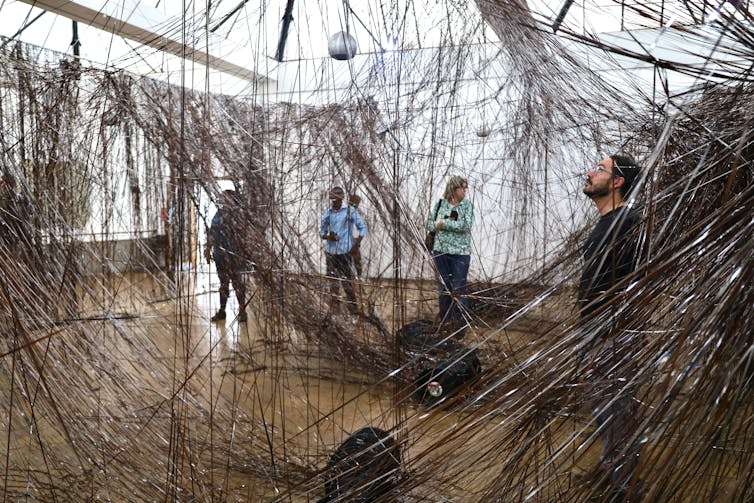
Lifang Zhang
Upon people coming into, it turns proper right into a performative piece. Some company quickly cross pathways, some get trapped, some contact and observe to look the traces of the earlier. The artist turns into the viewers, watching the work being (re)achieved by the people.
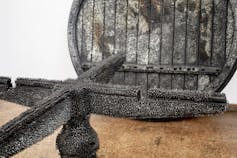
Lifang Zhang
A sequence of wall-hung sculptures, Colonial Product, hyperlinks these installations with Sando Dzako (Large Up) by which an entire bunch of nails are hammered proper right into a dismantled and burnt colonial consuming desk. It suggests it’s time to have a dialog over colonial presence. Or, as Muchemwa acknowledged in her opening night speech:
How we’re in a position to break points, to unburden meanings, to fiddle and uncover choices. To open areas throughout the meanings, areas by which we’re in a position to inject ourselves so that we’re in a position to dispose of these stays.
The exhibition is on until 8 Would possibly
